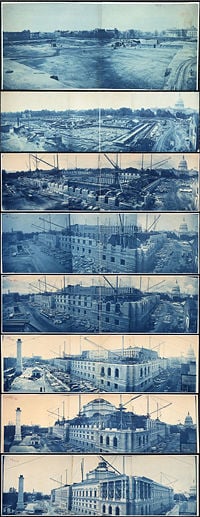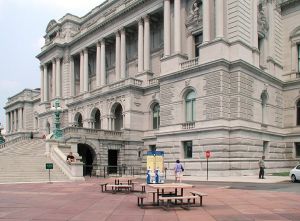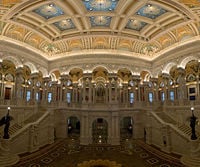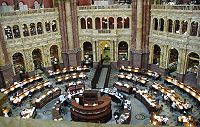Library of Congress
The Library of Congress, located in Washington D.C., is the national library of the United States, and represents the research arm of the U.S. Congress. It is one of the largest libraries in the world, holding more than 29 million books and printed materials in 470 languages. It is home to the world’s largest collection of legal materials, and the largest collection of published aeronautical literature. The collection is considered the largest rare book collection in North America.
The Library of Congress
The Library of Congress was established on April 24, 1800, when President John Adams signed an act of Congress allowing for the transfer of the U.S. Government body from Philadelphia, Pennsylvania to the new capital city of Washington, D.C. Today, the congressional library stands as the central depository of all written material copyrighted in the United States, and holds the most comprehensive collection of human creativity and knowledge in the world.
Early History
The congressional act passed by President Adams appropriated $5,000 for the purchase of a collection of books deemed necessary for the use of Congress, and for fitting the establishment of a suitable apartment for containing them. The original library was housed in the new U.S. Capitol until August 1814, when invading British troops set fire to the Capitol building during the burning of Washington, destroying the contents of the 3,000 volume library.
Within a month, former President Thomas Jefferson offered his personal library as a replacement. Jefferson’s library was considered to be one of the finest in the United States, as the President had spent more than 50 years accumulating books. The former President anticipated some controversy over the nature of his collection, which included books in foreign languages, and volumes of philosophy, science, literature, and other topics not normally viewed as part of a legislative library.
In January 1815, Congress accepted Jefferson's offer, appropriating $23,950 for his 6,487 books, and the foundation was laid for a great national library. The Jeffersonian concept of universality, the belief that all subjects are important to the library of the American legislature, became the philosophy and rationale behind the comprehensive collection policy of the Library of Congress.
On December 24, 1851, a fire destroyed the library’s 35,000 books, an original portrait of Christopher Columbus, portraits of the first five Presidents, and statues of George Washington, Thomas Jefferson, and Marquis de Lafayette. By the end of the Civil War, the Library had recovered an estimated 82,000 volumes.
Funding
The Library of Congress exists on congressional appropriations, and an income sustained through the establishment of library funds. In addition to welcomed donations, the library relies on the contributions of national foundations and private sources through the Library of Congress Trust Fund Board.
Responsibilities
The primary responsibility of the Library is to serve members of Congress in the objective research of congressional agendas. This responsibility of the Library is handled by its Congressional Research Service (CRS). This branch was designed for the exclusive use by the U.S. legislature and assists members of congress in their legislative and representative functions. The CRS is estimated to answer more than 5,000 requests for information per year and maintains specialized reading lists, automated information systems, and several research subdivisions for the personal use of congressional representatives and their staff.
The Library of Congress is spread over three buildings in Washington, D.C and encompasses the 1897 Thomas Jefferson Building, the 1938 John Adams Building, and the 1981 James Madison Memorial Building. In November of 2005, the Library announced its intentions to launch the World Digital Library, a digital preservation of books and other objects from cultures all over the world.
Annual events of the Library of Congress include the National Book Festival, the Founder’s Day Celebration, the Archives Fair, and the Davidson Fellows Reception.
The Librarian of Congress is a position appointed by the President of the United States with the consent of the U.S. senate. Under President Lincoln, the Librarian of Congress was awarded two free copies of every publication submitted for copyright in the United States. This allowance stands today.
Collections
The Library of Congress holds an esteemed collection of publications ranging from books, pamphlets, and audiotapes, to drawings, diaries, and films. The Library is home to the world’s largest collection of published aeronautical literature, and possesses the personal papers of most U.S. Presidents including George Washington, Abraham Lincoln, and Calvin Coolidge.
The extensive collection includes over 1 million U.S. Government publications, 1 million issues of world newspapers spanning the past three centuries, 33,000 bound newspaper volumes, 500,000 microfilm reels, and over 6,000 comic books. The library houses an extensive collection of interactive media items including films, 4.8 million maps, sheet music, 2.7 million sound recordings, and more than 58 million manuscripts.
The Library also holds an array of personal papers from various figures around the world including Margaret Mead, Henry Kissinger, Thurgood Marshall, and Sigmund Freud. The collection includes one of the three existing Gutenberg Bibles, and a Sumerian scripted tablet dating back to 2040 B.C.E., the oldest written material in the world.
Holdings
The congressional library developed a system of book classifications called the Library of Congress Classification, or LC Classification. These classifications are used by most U.S. research and university libraries, though most public libraries continue to use the Dewey Decimal system of classification.
The Library of Congress serves as a legal repository for copyright protection and registration, and as the base for the United States Copyright Office. Regardless of whether they are seeking copyright, all publishers are required by “mandatory deposit” to submit two copies of their "copyrightable" works to the Library. Each business day, nearly 22,000 new items published in the United States arrive at the Library. The Library does not retain all of these works in its permanent collection, but does add an estimated 10,000 items per day. Rejected items are used in trades with other libraries around the world, distributed to federal agencies, or donated to schools, communities, and other organizations throughout the United States. As is true of many National libraries, the Library of Congress retains copies of every publication in the English language.
The Library of Congress is listed as the largest library in the world, based on the shelf space its collection occupies. The Library states that its collection covers about 530 miles. The British Library is reported to cover an estimated 388 miles of shelf space. The Library of Congress holds about 130 million items with 29 million books, as compared to the United Kingdom’s 150 million items and 25 million books.
Internet Archives
The Library of Congress makes millions of digital objects available at its American Memory site. American Memory is a source for public domain image resources, as well as audio, video, and archived Web content. Nearly all of the listed holdings can be found directly on its web site. Librarians all over the world consult these catalogs when seeking to add to their collection a book published in the United States. Using the Library of Congress Control Number, librarians can make sure of the exact identity of the book.
The Library of Congress also provides an on-line archive of the proceedings of the Congress of the United States including bill text, Congressional Record text, bill summaries, the Congressional Record Index, and the U.S. Constitution. The Library also administers the National Library Service for the Blind and Physically Handicapped, an audio and Braille library program provided to more than 766,000 Americans.
Preservation
The preservation of the Library’s collection revolves around the conservation, binding, and digitization of the institute’s original materials. Publication preservation is conducted by the Library’s Preservation, Research and Testing office, which is responsible for ensuring the general survival, conservation, and public availability of each article of the congressional library.
Using the Library
The library is open to the general public for academic research, and runs tours for visitors. Only those who are issued a "Reader Identification Card" may enter the reading rooms to access the collection. The Reader Identification Card is available in the Madison building to persons who are over 18 years of age upon presentation of a government issued picture identification card.
Only certain government officials, including Supreme Court Justices and their staff, and members of Congress and their staff are allowed to check books out. University libraries may also request items through interlibrary loan from the Library of Congress, if no other American institution possesses the item. The Library is also involved in various standard activities related to bibliographical and search and retrieve standards.
Future
The Library of Congress remains the largest up-to-date library in the world, and employs a number of technological initiatives to stay current. In order to make its diverse collection of resources readily available, the Library of Congress has established an office of strategic initiatives, an information technology service, and the most comprehensive online library in the world through the National Digital Library Program.
The National Digital Library Program has allowed the Library of Congress to make its digitized collection easily accessible by a worldwide public audience. The Library’s resources and collections can be accessed free-of-charge via the internet and includes millions of records, online library exhibitions, and the entire card catalogue of the congressional library. The program has also established a comprehensive database, known as THOMAS, for the use of Congress members and their staff, and offers an optical disk system for Congressional members to supply them with a pocket library of public policy.
Though the times have changed and resources have advanced, the mission of the Library of Congress has remained the same. The institution continues to uphold a universally available collection, to sustain and preserve this collection, and to establish general policies and administrative duties to support and complete the mission of the congressional library.
ReferencesISBN links support NWE through referral fees
- West’s Encyclopedia of American Law. 1998. Library of Congress. The Gale Group, Inc.
- Foner, Eric and Garraty, John A. (Editors). 2006. Library of Congress. The Reader's Companion to American History. Houghton Mifflin Company.
External Links
- The Library of Congress
- Library of Congress History
- American Memory
- thomas.loc.gov Legislative Information
- Library Standards
Credits
New World Encyclopedia writers and editors rewrote and completed the Wikipedia article in accordance with New World Encyclopedia standards. This article abides by terms of the Creative Commons CC-by-sa 3.0 License (CC-by-sa), which may be used and disseminated with proper attribution. Credit is due under the terms of this license that can reference both the New World Encyclopedia contributors and the selfless volunteer contributors of the Wikimedia Foundation. To cite this article click here for a list of acceptable citing formats.The history of earlier contributions by wikipedians is accessible to researchers here:
The history of this article since it was imported to New World Encyclopedia:
Note: Some restrictions may apply to use of individual images which are separately licensed.




